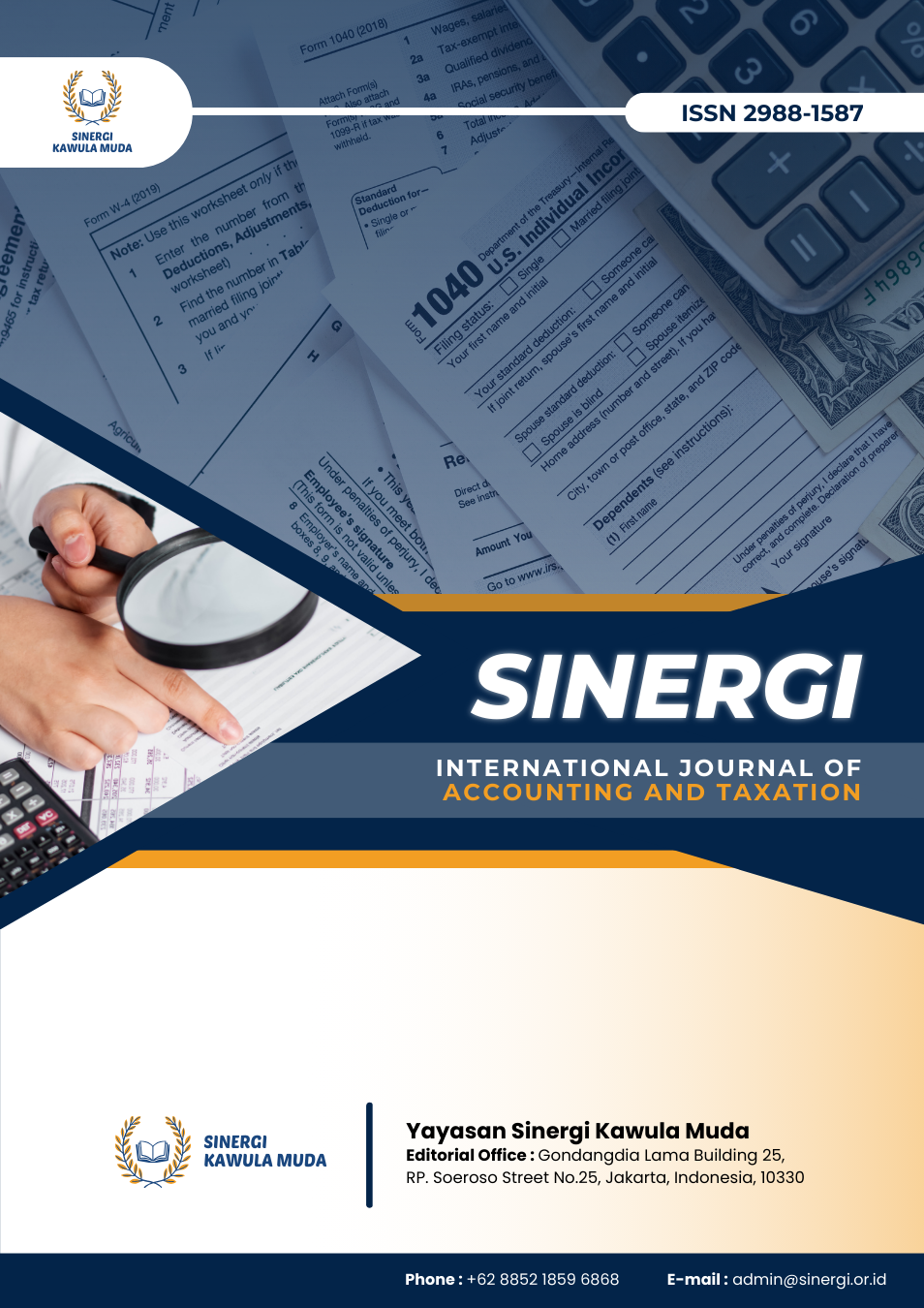Foreign Exchange Volatility and Corporate Risk Mitigation Approaches: Evidence from Indonesian SMEs
DOI:
https://doi.org/10.61194/ijat.v2i3.638Keywords:
Foreign Exchange Risk, Hedging Strategies, Financial Risk Management, Corporate Governance, Multinational Corporations, SMES, Currency FluctuationsAbstract
Foreign exchange (FX) risk management is crucial for firms operating in global markets, as currency fluctuations can significantly impact financial performance. This study explores the key determinants influencing firms' hedging decisions, the role of managerial characteristics, and the effectiveness of hedging strategies. Employing a qualitative approach, data were collected through in-depth interviews with financial executives and risk managers. The findings indicate that firms with higher foreign debt exposure and liquidity constraints are more likely to hedge against FX risks. Additionally, managerial risk aversion plays a critical role in determining hedging behavior, aligning with agency theory predictions. Furthermore, the study highlights the importance of integrating both financial and operational hedging strategies to optimize FX risk management. While large firms have better access to sophisticated hedging instruments, SMEs face significant challenges in managing FX exposure due to resource limitations. The study suggests that policymakers should enhance access to hedging tools for SMEs to improve financial resilience. These findings contribute to the existing literature on FX risk management by providing empirical evidence on the interplay between firm-specific factors, managerial characteristics, and hedging effectiveness. Future research should consider longitudinal studies to examine the dynamic nature of FX risk exposure and assess the long-term impact of hedging practices on firm performance.
References
Amer, I. (2014). Modelling Foreign Exchange Rate Exposure. Journal of Economic and Administrative Sciences, 30(2), 96–120. https://doi.org/10.1108/jeas-03-2013-0009 DOI: https://doi.org/10.1108/JEAS-03-2013-0009
Bodnar, G. M., Giambona, E., Graham, J. R., & Harvey, C. R. (2019). A View Inside Corporate Risk Management. Management Science, 65(11), 5001–5026. https://doi.org/10.1287/mnsc.2018.3081 DOI: https://doi.org/10.1287/mnsc.2018.3081
Bogićević, J., Dmitrović-Šaponja, L., & Pantelić, M. (2016). Foreign Exchange Transaction Exposure of Enterprises in Serbia. Economic Annals, 61(209), 161–177. https://doi.org/10.2298/eka1609161b DOI: https://doi.org/10.2298/EKA1609161B
Emenike, K. O. (2018). Exchange Rate Volatility in West African Countries: Is There a Shred of Spillover? International Journal of Emerging Markets, 13(6), 1457–1474. https://doi.org/10.1108/ijoem-08-2017-0312 DOI: https://doi.org/10.1108/IJoEM-08-2017-0312
Geyer‐Klingeberg, J., Hang, M., & Rathgeber, A. (2020). Corporate Financial Hedging and Firm Value: A Meta-Analysis. European Journal of Finance, 27(6), 461–485. https://doi.org/10.1080/1351847x.2020.1816559 DOI: https://doi.org/10.1080/1351847X.2020.1816559
Hakim, A. R., Salman, A. N. M., Ashari, Y. F., & Syuhada, K. (2022). Modifying (M)CoVaR and Constructing Tail Risk Networks Through Analytic Higher-Order Moments: Evidence From the Global Forex Markets. Plos One, 17(11), e0277756. https://doi.org/10.1371/journal.pone.0277756 DOI: https://doi.org/10.1371/journal.pone.0277756
Hecht, A. (2021). The Role of Managerial Characteristics in FX Risk Management: Who Increases Risk? Review of Managerial Science, 15(8), 2377–2406. https://doi.org/10.1007/s11846-020-00432-x DOI: https://doi.org/10.1007/s11846-020-00432-x
Hecht, A., & Lampenius, N. (2023). How Do Firms Manage Their Foreign Exchange Exposure? Journal of Risk and Financial Management, 16(8), 359. https://doi.org/10.3390/jrfm16080359 DOI: https://doi.org/10.3390/jrfm16080359
Hege, U., Hutson, E., & Laing, E. (2021a). Mandatory governance reform and corporate risk management. Journal of Corporate Finance, 68. https://doi.org/10.1016/j.jcorpfin.2021.101935
Hege, U., Hutson, E., & Laing, E. (2021b). Mandatory Governance Reform and Corporate Risk Management. Journal of Corporate Finance, 68, 101935. https://doi.org/10.1016/j.jcorpfin.2021.101935 DOI: https://doi.org/10.1016/j.jcorpfin.2021.101935
Heipertz, J., Mihov, I., & Santacreu, A. M. (2022). Managing Macroeconomic Fluctuations With Flexible Exchange Rate Targeting. Journal of Economic Dynamics and Control, 135, 104311. https://doi.org/10.1016/j.jedc.2022.104311 DOI: https://doi.org/10.1016/j.jedc.2022.104311
Ismail, S., & Ahmed, E. M. (2023). The Impact of Liquidity Risk, Credit Risk, and Operational Risk on Financial Stability in Conventional Banks in Jordan. Uncertain Supply Chain Management, 11(2), 433–442. https://doi.org/10.5267/j.uscm.2023.3.006 DOI: https://doi.org/10.5267/j.uscm.2023.3.006
Lee, S., Kim, Y. K., & Kim, K.-H. (2015). Corporate Governance, Firm Risk, and Corporate Social Responsibility: Evidence From Korean Firms. Journal of Applied Business Research (Jabr), 32(1), 303. https://doi.org/10.19030/jabr.v32i1.9539 DOI: https://doi.org/10.19030/jabr.v32i1.9539
Lin, H., Sun, Q., & Chen, S.-Q. (2020). Reducing Exchange Rate Risks in International Trade: A Hybrid Forecasting Approach of CEEMDAN and Multilayer LSTM. Sustainability, 12(6), 2451. https://doi.org/10.3390/su12062451 DOI: https://doi.org/10.3390/su12062451
Loriot, B., Hutson, E., & Yong, H. H. A. (2019). Equity-Linked Executive Compensation, Hedging and Foreign Exchange Exposure: Australian Evidence. Australian Journal of Management, 45(1), 72–93. https://doi.org/10.1177/0312896219830158 DOI: https://doi.org/10.1177/0312896219830158
M., P. B., & Lukose, P. J. J. (2017). The Determinants of Currency Derivatives Usage Among Indian Non-Financial Firms. Studies in Economics and Finance, 34(3), 363–382. https://doi.org/10.1108/sef-09-2014-0172 DOI: https://doi.org/10.1108/SEF-09-2014-0172
Min, Y., & Yang, O. (2019). The Impact of Exchange Volatility Exposure on Firms’ Foreign-Denominated Debts. Management Decision, 57(11), 3035–3060. https://doi.org/10.1108/md-04-2017-0383 DOI: https://doi.org/10.1108/MD-04-2017-0383
Moagar-Poladian, S., Clichici, D., & Stanciu, C.-V. (2019). The comovement of exchange rates and stock markets in Central and Eastern Europe. Sustainability (Switzerland), 11(14). https://doi.org/10.3390/su11143985 DOI: https://doi.org/10.3390/su11143985
Nakatani, J., Maruyama, T., Fukuchi, K., & Moriguchi, Y. (2015). A Practical Approach to Screening Potential Environmental Hotspots of Different Impact Categories in Supply Chains. Sustainability, 7(9), 11878–11892. https://doi.org/10.3390/su70911878 DOI: https://doi.org/10.3390/su70911878
Ning, C., Xu, D., & Wirjanto, T. S. (2015). Is Volatility Clustering of Asset Returns Asymmetric? Journal of Banking & Finance, 52, 62–76. https://doi.org/10.1016/j.jbankfin.2014.11.016 DOI: https://doi.org/10.1016/j.jbankfin.2014.11.016
Pichler, A., Poledna, S., & Thurner, S. (2021). Systemic Risk-Efficient Asset Allocations: Minimization of Systemic Risk as a Network Optimization Problem. Journal of Financial Stability, 52, 100809. https://doi.org/10.1016/j.jfs.2020.100809 DOI: https://doi.org/10.1016/j.jfs.2020.100809
Sayed, Z. B., & Gayathri, J. (2021). Factors Determining the Exchange Rate Exposure of Firms: Evidence From India. Business Perspectives and Research, 11(2), 210–226. https://doi.org/10.1177/22785337211033766 DOI: https://doi.org/10.1177/22785337211033766
Sendy, S., & Basaria, F. T. (2023). A Comparative Analysis of Hazard Analysis Methods for Sustainable Energy Development. E3s Web of Conferences, 388, 01037. https://doi.org/10.1051/e3sconf/202338801037 DOI: https://doi.org/10.1051/e3sconf/202338801037
Sengupta, R., & Gupta, A. S. (2019). Alternate Instruments to Manage the Capital Flow Conundrum: A Study of Selected Asian Economies. Pacific Economic Review, 24(2), 241–268. https://doi.org/10.1111/1468-0106.12296 DOI: https://doi.org/10.1111/1468-0106.12296
Sławik, A., & Bohatkiewicz-Czaicka, J. (2022). Financial Innovation of Mass Destruction—The Story of a Countrywide FX Options Debacle. Risks, 10(2), 28. https://doi.org/10.3390/risks10020028 DOI: https://doi.org/10.3390/risks10020028
Tang, M.-L., Wu, T., & Hung, M.-C. (2022). Optimal Pension Fund Management With Foreign Investment in a Stochastic Environment. Mathematics, 10(14), 2468. https://doi.org/10.3390/math10142468 DOI: https://doi.org/10.3390/math10142468
Yavas, B. F., Dedi, L., & Škrinjarić, T. (2020). Did Equity Returns and Volatilities Change After the 2016 Trump Election Victory? International Journal of Finance & Economics, 27(1), 1291–1308. https://doi.org/10.1002/ijfe.2215 DOI: https://doi.org/10.1002/ijfe.2215
Yudha, J. O. M., Oktavia, R., & Desriani, N. (2023). The Effect of Foreign Debt, Liquidity, Firm Size, and Exchange Rate on Hedging Decision. Journal of Indonesian Economy and Business, 38(2). https://doi.org/10.22146/jieb.v38i2.5887 DOI: https://doi.org/10.22146/jieb.v38i2.5887
Zahedi, J., Salehi, M., & Moradi, M. (2021). Identifying and Classifying the Contributing Factors to Financial Resilience. Foresight, 24(2), 177–194. https://doi.org/10.1108/fs-10-2020-0102 DOI: https://doi.org/10.1108/FS-10-2020-0102
Zhang, Y., Chen, R., & Ma, D. (2020). A weighted and directed perspective of global stock market connectedness: A variance decomposition and GERGM framework. Sustainability (Switzerland), 12(11). https://doi.org/10.3390/su12114605 DOI: https://doi.org/10.3390/su12114605
Downloads
Published
How to Cite
Issue
Section
License
Copyright (c) 2024 Ira Nasriani

This work is licensed under a Creative Commons Attribution 4.0 International License.






